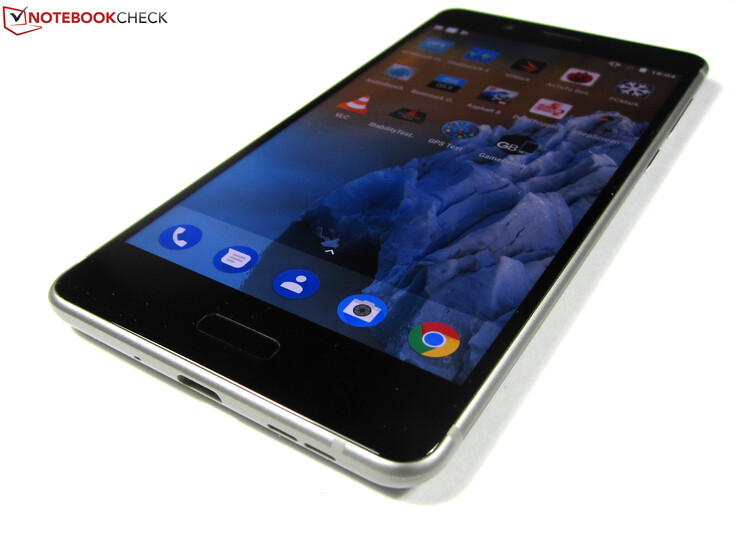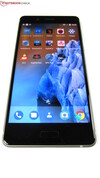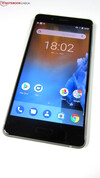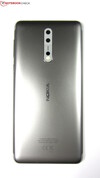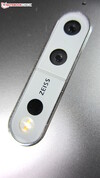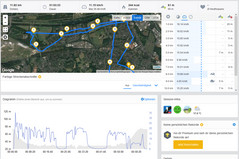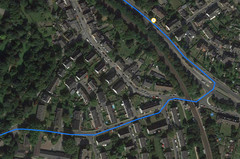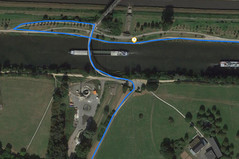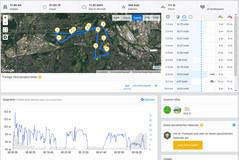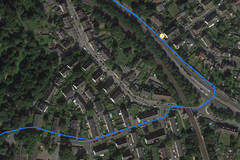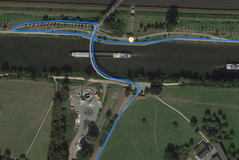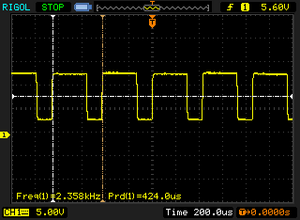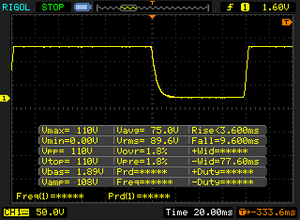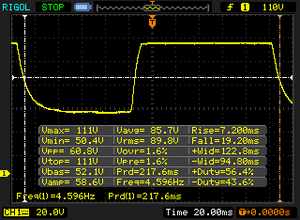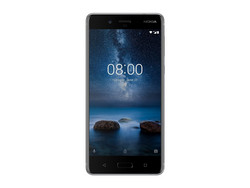Breve Análise do Smartphone Nokia 8
Os Top 10
» Os Top 10 Portáteis Multimídia
» Os Top 10 Portáteis de Jogos
» Os Top 10 Portáteis Leves para Jogos
» Os Top 10 Portáteis Acessíveis de Escritório/Empresariais
» Os Top 10 Portáteis Premium de Escritório/Empresariais
» Os Top 10 dos Portáteis Workstation
» Os Top 10 Subportáteis
» Os Top 10 Ultrabooks
» Os Top 10 Conversíveis
» Os Top 10 Tablets
» Os Top 10 Smartphones
» A melhores Telas de Portáteis Analisadas Pela Notebookcheck
» Top 10 dos portáteis abaixo dos 500 Euros da Notebookcheck
» Top 10 dos Portáteis abaixo dos 300 Euros
Size Comparison
| Networking | |
| iperf3 transmit AX12 | |
| Samsung Galaxy S8 | |
| HTC U11 | |
| OnePlus 5 | |
| Apple iPhone 8 | |
| Nokia 8 | |
| iperf3 receive AX12 | |
| Apple iPhone 8 | |
| HTC U11 | |
| OnePlus 5 | |
| Samsung Galaxy S8 | |
| Nokia 8 | |
| |||||||||||||||||||||||||
iluminação: 92 %
iluminação com acumulador: 735 cd/m²
Contraste: 930:1 (Preto: 0.79 cd/m²)
ΔE ColorChecker Calman: 6.7 | ∀{0.5-29.43 Ø4.78}
ΔE Greyscale Calman: 8.3 | ∀{0.09-98 Ø5}
Gamma: 2.24
CCT: 8906 K
| Nokia 8 IPS, 2560x1440, 5.3" | OnePlus 5 AMOLED, 1920x1080, 5.5" | HTC U11 Super LCD5, 2560x1440, 5.5" | Samsung Galaxy S8 Super AMOLED, 2960x1440, 5.8" | Apple iPhone 8 IPS True Tone, 1334x750, 4.7" | |
|---|---|---|---|---|---|
| Screen | 24% | 29% | 23% | 38% | |
| Brightness middle (cd/m²) | 735 | 426 -42% | 482 -34% | 566 -23% | 604 -18% |
| Brightness (cd/m²) | 707 | 431 -39% | 472 -33% | 564 -20% | 580 -18% |
| Brightness Distribution (%) | 92 | 93 1% | 90 -2% | 94 2% | 91 -1% |
| Black Level * (cd/m²) | 0.79 | 0.33 58% | 0.44 44% | ||
| Contrast (:1) | 930 | 1461 57% | 1373 48% | ||
| Colorchecker dE 2000 * | 6.7 | 1.6 76% | 3.2 52% | 2.7 60% | 1.2 82% |
| Colorchecker dE 2000 max. * | 12.9 | 4.1 68% | 5.4 58% | 5.4 58% | 2.3 82% |
| Greyscale dE 2000 * | 8.3 | 1.7 80% | 2.2 73% | 3.1 63% | 1.6 81% |
| Gamma | 2.24 98% | 2.25 98% | 2.22 99% | 2.15 102% | 2.25 98% |
| CCT | 8906 73% | 6329 103% | 6581 99% | 6335 103% | 6688 97% |
| Color Space (Percent of AdobeRGB 1998) (%) | 81.57 | ||||
| Color Space (Percent of sRGB) (%) | 99.87 |
* ... menor é melhor
Cintilação da tela / PWM (modulação por largura de pulso)
| Tela tremeluzindo/PWM detectado | 2358 Hz | ≤ 17 % configuração de brilho | |
A luz de fundo da tela pisca em 2358 Hz (pior caso, por exemplo, utilizando PWM) Cintilação detectada em uma configuração de brilho de 17 % e abaixo. Não deve haver cintilação ou PWM acima desta configuração de brilho. A frequência de 2358 Hz é bastante alta, então a maioria dos usuários sensíveis ao PWM não deve notar nenhuma oscilação. [pwm_comparison] Em comparação: 53 % de todos os dispositivos testados não usam PWM para escurecer a tela. Se PWM foi detectado, uma média de 8118 (mínimo: 5 - máximo: 343500) Hz foi medida. | |||
Exibir tempos de resposta
| ↔ Tempo de resposta preto para branco | ||
|---|---|---|
| 13.2 ms ... ascensão ↗ e queda ↘ combinadas | ↗ 3.6 ms ascensão | |
| ↘ 9.6 ms queda | ||
| A tela mostra boas taxas de resposta em nossos testes, mas pode ser muito lenta para jogadores competitivos. Em comparação, todos os dispositivos testados variam de 0.1 (mínimo) a 240 (máximo) ms. » 33 % de todos os dispositivos são melhores. Isso significa que o tempo de resposta medido é melhor que a média de todos os dispositivos testados (20.2 ms). | ||
| ↔ Tempo de resposta 50% cinza a 80% cinza | ||
| 26.4 ms ... ascensão ↗ e queda ↘ combinadas | ↗ 7.2 ms ascensão | |
| ↘ 19.2 ms queda | ||
| A tela mostra taxas de resposta relativamente lentas em nossos testes e pode ser muito lenta para os jogadores. Em comparação, todos os dispositivos testados variam de 0.165 (mínimo) a 636 (máximo) ms. » 35 % de todos os dispositivos são melhores. Isso significa que o tempo de resposta medido é melhor que a média de todos os dispositivos testados (31.6 ms). | ||
| AnTuTu v6 - Total Score (classificar por valor) | |
| Nokia 8 | |
| OnePlus 5 | |
| HTC U11 | |
| Samsung Galaxy S8 | |
| Apple iPhone 8 | |
| PCMark for Android | |
| Work performance score (classificar por valor) | |
| Nokia 8 | |
| OnePlus 5 | |
| HTC U11 | |
| Samsung Galaxy S8 | |
| Work 2.0 performance score (classificar por valor) | |
| Nokia 8 | |
| OnePlus 5 | |
| HTC U11 | |
| Samsung Galaxy S8 | |
| Geekbench 4.4 | |
| 64 Bit Single-Core Score (classificar por valor) | |
| Nokia 8 | |
| OnePlus 5 | |
| HTC U11 | |
| Samsung Galaxy S8 | |
| Apple iPhone 8 | |
| 64 Bit Multi-Core Score (classificar por valor) | |
| Nokia 8 | |
| OnePlus 5 | |
| HTC U11 | |
| Samsung Galaxy S8 | |
| Apple iPhone 8 | |
| Compute RenderScript Score (classificar por valor) | |
| OnePlus 5 | |
| HTC U11 | |
| Samsung Galaxy S8 | |
| GFXBench (DX / GLBenchmark) 2.7 | |
| T-Rex Onscreen (classificar por valor) | |
| Nokia 8 | |
| OnePlus 5 | |
| HTC U11 | |
| Samsung Galaxy S8 | |
| Apple iPhone 8 | |
| 1920x1080 T-Rex Offscreen (classificar por valor) | |
| Nokia 8 | |
| OnePlus 5 | |
| HTC U11 | |
| Samsung Galaxy S8 | |
| Apple iPhone 8 | |
| GFXBench 3.0 | |
| on screen Manhattan Onscreen OGL (classificar por valor) | |
| Nokia 8 | |
| OnePlus 5 | |
| HTC U11 | |
| Samsung Galaxy S8 | |
| Apple iPhone 8 | |
| 1920x1080 1080p Manhattan Offscreen (classificar por valor) | |
| Nokia 8 | |
| OnePlus 5 | |
| HTC U11 | |
| Samsung Galaxy S8 | |
| Apple iPhone 8 | |
| GFXBench 3.1 | |
| on screen Manhattan ES 3.1 Onscreen (classificar por valor) | |
| Nokia 8 | |
| OnePlus 5 | |
| HTC U11 | |
| Samsung Galaxy S8 | |
| Apple iPhone 8 | |
| 1920x1080 Manhattan ES 3.1 Offscreen (classificar por valor) | |
| Nokia 8 | |
| OnePlus 5 | |
| HTC U11 | |
| Samsung Galaxy S8 | |
| Apple iPhone 8 | |
| GFXBench | |
| on screen Car Chase Onscreen (classificar por valor) | |
| Nokia 8 | |
| OnePlus 5 | |
| HTC U11 | |
| Samsung Galaxy S8 | |
| 1920x1080 Car Chase Offscreen (classificar por valor) | |
| Nokia 8 | |
| OnePlus 5 | |
| HTC U11 | |
| Samsung Galaxy S8 | |
| JetStream 1.1 - Total Score | |
| Apple iPhone 8 | |
| OnePlus 5 (Chrome 59) | |
| HTC U11 (Chrome 58) | |
| Samsung Galaxy S8 (Samsung Browser 5.2) | |
| Nokia 8 (Chrome 61.0.3163.98) | |
| Octane V2 - Total Score | |
| Apple iPhone 8 | |
| Samsung Galaxy S8 (Samsung Browser 5.2) | |
| OnePlus 5 (Chrome 59) | |
| HTC U11 (Chrome 58) | |
| Nokia 8 (Chrome 61.0.3163.98) | |
| Mozilla Kraken 1.1 - Total | |
| Nokia 8 (Chrome 61.0.3163.98) | |
| HTC U11 (Chrome 58) | |
| OnePlus 5 (Chrome 59) | |
| Samsung Galaxy S8 (Samsung Browser 5.2) | |
| Apple iPhone 8 | |
| WebXPRT 2015 - Overall | |
| Apple iPhone 8 | |
| Samsung Galaxy S8 (Samsung Browser 5.2) | |
| Nokia 8 (Chrome 61.0.3163.98) | |
| HTC U11 (Chrome 58) | |
| OnePlus 5 (Chrome 59) | |
* ... menor é melhor
| Nokia 8 | OnePlus 5 | HTC U11 | Samsung Galaxy S8 | |
|---|---|---|---|---|
| AndroBench 3-5 | 10% | 67% | -1% | |
| Sequential Read 256KB (MB/s) | 680 | 748 10% | 717 5% | 793 17% |
| Sequential Write 256KB (MB/s) | 199.1 | 201.5 1% | 206.4 4% | 193.2 -3% |
| Random Read 4KB (MB/s) | 145.7 | 141 -3% | 91.4 -37% | 127.2 -13% |
| Random Write 4KB (MB/s) | 14.57 | 19.3 32% | 80 449% | 15.25 5% |
| Sequential Read 256KB SDCard (MB/s) | 76.8 ? | 68.8 ? -10% | 63.9 ? -17% | |
| Sequential Write 256KB SDCard (MB/s) | 51.7 ? | 46.25 ? -11% | 53.5 ? 3% |
| Dead Trigger 2 | |||
| Configurações | Valor | ||
| high | 60 fps | ||
| Asphalt 8: Airborne | |||
| Configurações | Valor | ||
| high | 30 fps | ||
| very low | 30 fps | ||
(-) A temperatura máxima no lado superior é 45.1 °C / 113 F, em comparação com a média de 35.2 °C / 95 F , variando de 21.9 a 247 °C para a classe Smartphone.
(+) A parte inferior aquece até um máximo de 38.3 °C / 101 F, em comparação com a média de 34 °C / 93 F
(±) Em uso inativo, a temperatura média para o lado superior é 34.3 °C / 94 F, em comparação com a média do dispositivo de 32.9 °C / ### class_avg_f### F.
Nokia 8 análise de áudio
(+) | os alto-falantes podem tocar relativamente alto (###valor### dB)
Graves 100 - 315Hz
(-) | quase nenhum baixo - em média 26.6% menor que a mediana
(+) | o baixo é linear (5.9% delta para a frequência anterior)
Médios 400 - 2.000 Hz
(±) | médios reduzidos - em média 6.7% menor que a mediana
(+) | médios são lineares (5.6% delta para frequência anterior)
Altos 2 - 16 kHz
(±) | máximos mais altos - em média 8% maior que a mediana
(+) | os máximos são lineares (5% delta da frequência anterior)
Geral 100 - 16.000 Hz
(±) | a linearidade do som geral é média (21.9% diferença em relação à mediana)
Comparado com a mesma classe
» 44% de todos os dispositivos testados nesta classe foram melhores, 8% semelhantes, 48% piores
» O melhor teve um delta de 11%, a média foi 35%, o pior foi 134%
Comparado com todos os dispositivos testados
» 62% de todos os dispositivos testados foram melhores, 7% semelhantes, 31% piores
» O melhor teve um delta de 4%, a média foi 24%, o pior foi 134%
Apple iPhone 8 análise de áudio
(±) | o volume do alto-falante é médio, mas bom (###valor### dB)
Graves 100 - 315Hz
(±) | graves reduzidos - em média 14.6% menor que a mediana
(±) | a linearidade dos graves é média (9.2% delta para a frequência anterior)
Médios 400 - 2.000 Hz
(+) | médios equilibrados - apenas 4.3% longe da mediana
(+) | médios são lineares (4.2% delta para frequência anterior)
Altos 2 - 16 kHz
(±) | máximos mais altos - em média 5.1% maior que a mediana
(+) | os máximos são lineares (4.7% delta da frequência anterior)
Geral 100 - 16.000 Hz
(±) | a linearidade do som geral é média (18.2% diferença em relação à mediana)
Comparado com a mesma classe
» 17% de todos os dispositivos testados nesta classe foram melhores, 8% semelhantes, 74% piores
» O melhor teve um delta de 11%, a média foi 35%, o pior foi 134%
Comparado com todos os dispositivos testados
» 38% de todos os dispositivos testados foram melhores, 8% semelhantes, 54% piores
» O melhor teve um delta de 4%, a média foi 24%, o pior foi 134%
Samsung Galaxy S8 análise de áudio
(+) | os alto-falantes podem tocar relativamente alto (###valor### dB)
Graves 100 - 315Hz
(-) | quase nenhum baixo - em média 22.1% menor que a mediana
(±) | a linearidade dos graves é média (11.7% delta para a frequência anterior)
Médios 400 - 2.000 Hz
(±) | médios mais altos - em média 5% maior que a mediana
(+) | médios são lineares (4.3% delta para frequência anterior)
Altos 2 - 16 kHz
(+) | agudos equilibrados - apenas 3.7% longe da mediana
(+) | os máximos são lineares (6.7% delta da frequência anterior)
Geral 100 - 16.000 Hz
(±) | a linearidade do som geral é média (21.8% diferença em relação à mediana)
Comparado com a mesma classe
» 44% de todos os dispositivos testados nesta classe foram melhores, 8% semelhantes, 48% piores
» O melhor teve um delta de 11%, a média foi 35%, o pior foi 134%
Comparado com todos os dispositivos testados
» 61% de todos os dispositivos testados foram melhores, 7% semelhantes, 32% piores
» O melhor teve um delta de 4%, a média foi 24%, o pior foi 134%
| desligado | |
| Ocioso | |
| Carga |
|
Key:
min: | |
| Nokia 8 3090 mAh | OnePlus 5 3300 mAh | HTC U11 3000 mAh | Samsung Galaxy S8 3000 mAh | Apple iPhone 8 1821 mAh | |
|---|---|---|---|---|---|
| Power Consumption | 9% | 11% | 33% | 29% | |
| Idle Minimum * (Watt) | 0.86 | 0.73 15% | 0.73 15% | 0.78 9% | 0.54 37% |
| Idle Average * (Watt) | 2.13 | 1.44 32% | 1.96 8% | 1.1 48% | 1.63 23% |
| Idle Maximum * (Watt) | 2.16 | 1.5 31% | 1.98 8% | 1.16 46% | 1.67 23% |
| Load Average * (Watt) | 4.65 | 6.91 -49% | 4.82 -4% | 4.15 11% | 2.74 41% |
| Load Maximum * (Watt) | 9.99 | 8.51 15% | 7.15 28% | 5.12 49% | 7.78 22% |
* ... menor é melhor
| Nokia 8 3090 mAh | OnePlus 5 3300 mAh | HTC U11 3000 mAh | Samsung Galaxy S8 3000 mAh | Apple iPhone 8 1821 mAh | |
|---|---|---|---|---|---|
| Duração da bateria | -8% | -19% | 10% | -5% | |
| Reader / Idle (h) | 25.1 | 25.6 2% | 20.8 -17% | 27.8 11% | 27.2 8% |
| H.264 (h) | 12.2 | 10.4 -15% | 8.3 -32% | 12.9 6% | 11.6 -5% |
| WiFi v1.3 (h) | 10.8 | 8.6 -20% | 9.3 -14% | 12 11% | 9.8 -9% |
| Load (h) | 4 | 4.1 3% | 3.5 -12% | 4.4 10% | 3.4 -15% |
Pro
Contra
O Nokia 8 ganha pontos com sua carcaça de alumínio soberbamente construída e uma tela QHD de 5,3 polegadas muito brilhante. Também ganha pontos de simpatia com o seu sofisticado So Qualcomm Snapdragon 835. Isto, juntamente com 4 GB de RAM e o acelerador Adreno 540 pixel, garante sempre uma velocidade de operação rápida. Depois está a longa duração da bateria, carregamento rápido via Quick Charge 3.0 e inclusive um ponto forte exclusivo com o "Bothie": A câmera de 13 MP no Nokia 8 pode tirar fotos e gravar vídeos simultaneamente com sua webcam e câmera principal, em um tipo de modo de tela dividido e cria uma quase selfie dupla. Isto também funciona com a resolução 4K em vídeos e é acompanhado por um excelente com surround Ozo 360°, graças aos três microfones.
Com o Nokia 8, a HMD Global oferece um smartphone de gama alta que é muito avançado em quase todos os aspectos e, portanto, posiciona-se corretamente na órbita de líderes, como o iPhone 8 da Apple ou o Galaxy S8 da Samsung. No entanto, ele não exatamente no mesmo nível com os rivais fortes.
Ao desconsiderar o modo especial inovador das câmeras que provavelmente atrairá usuários criativos, o Nokia 8 ainda é um smartphone muito bom. No entanto, pequenas discrepâncias impedem que ele atinja um grau mais elevado. Por exemplo, uma classificação de proteção IP67 que protege o aparelho de entrada de água e poeira pode ser esperada de um dispositivo de gama premium. Também teríamos desejado que o veloz módulo LTE suportasse mais frequências. Uma ou outra banda de frequência ausente evita que o Nokia 8 seja um verdadeiro cidadão do mundo. A velocidade de transmissão Wi-Fi também não é muito estimulante em comparação com a concorrência premium.
Além da variante de um só SIM que testamos, a Nokia também oferece o 8 em uma versão com slot para dois SIMs. Além disso, um modelo com 128 GB de armazenamento será lançado em breve. No entanto, informações sobre isso não podem ser encontradas no site em alemão da Nokia, no momento deste teste.
Nokia 8
- 10/19/2017 v6 (old)
Manuel Masiero




